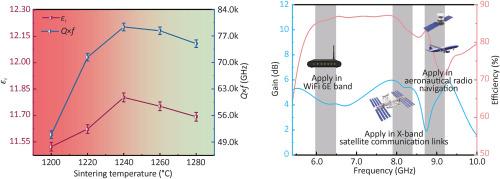Tailoring microwave dielectric properties of MgAl5/4(Li1/3Ti2/3)3/4O4 ceramics for multi-band dielectric resonant antenna
IF 9.6
1区 材料科学
Q1 CHEMISTRY, PHYSICAL
引用次数: 0
Abstract
This study introduces a novel microwave dielectric ceramic, MgAl5/4(Li1/3Ti2/3)3/4O4, tailored for modern communication technologies. MgAl5/4(Li1/3Ti2/3)3/4O4 ceramics feature a composite spinel structure (Fd-3m space group) comprising MgAl2O4 and Li4Ti5O12 type phases. By substituting Al3+ of MgAl2O4 ceramic with the composite ion (Li1/3Ti2/3)3+, differences in elemental diffusion induced by sintering temperature (1200–1280 °C) significantly affect the microwave dielectric properties: a low εᵣ (11.83) and enhanced microwave properties (Q×f = 79,381 GHz and τf = −28.5 × 10−6/°C) at 1240 °C. With further optimization of the ceramics, a near-zero τf is realized in 0.93MgAl5/4(Li1/3Ti2/3)3/4O4-0.07CaTiO3 ceramics with excellent comprehensive performance (εr = 14.36, Q×f = 44,144 GHz). Building on this, a multi-band dielectric resonant antenna (DRA) was designed for applications in communication and aeronautical radio navigation, featuring a wide relative bandwidth of 39.37% (5.97–6.49 GHz and 7.19–9.83 GHz). This study presents an optimization strategy for obtaining microwave dielectric ceramics with low εr, high Q×f, excellent frequency-temperature stability, low sintering temperature, and low density.


多波段介电谐振天线用MgAl5/4(Li1/3Ti2/3)3/4O4陶瓷的微波介电特性定制
本文介绍了一种为现代通信技术量身定制的新型微波介质陶瓷MgAl5/4(Li1/3Ti2/3)3/4O4。MgAl5/4(Li1/3Ti2/3)3/4O4陶瓷具有由MgAl2O4和Li4Ti5O12型相组成的复合尖晶石结构(Fd-3m空间群)。用复合离子(Li1/3Ti2/3)3+取代MgAl2O4陶瓷的Al3+,烧结温度(1200 ~ 1280℃)引起的元素扩散差异显著影响了MgAl2O4陶瓷的微波介电性能:1240℃时εᵣ(11.8)较低,微波性能(Q×f = 79,381 GHz, τf = -28.5×10−6/°C)增强。进一步优化陶瓷,得到综合性能优良的0.93MgAl5/4(Li1/3Ti2/3)3/4O4-0.07CaTiO3陶瓷的τf接近于零(εr = 14.36, Q×f = 44,144 GHz)。在此基础上,设计了一种适用于通信和航空无线电导航的多频段介质谐振天线(DRA),相对带宽为39.37% (5.97 ~ 6.49 GHz和7.19 ~ 9.83 GHz)。本研究提出了一种获得低εr、高Q×f、优异的频温稳定性、低烧结温度和低密度微波介质陶瓷的优化策略。
本文章由计算机程序翻译,如有差异,请以英文原文为准。
求助全文
约1分钟内获得全文
求助全文
来源期刊

Journal of Materiomics
Materials Science-Metals and Alloys
CiteScore
14.30
自引率
6.40%
发文量
331
审稿时长
37 days
期刊介绍:
The Journal of Materiomics is a peer-reviewed open-access journal that aims to serve as a forum for the continuous dissemination of research within the field of materials science. It particularly emphasizes systematic studies on the relationships between composition, processing, structure, property, and performance of advanced materials. The journal is supported by the Chinese Ceramic Society and is indexed in SCIE and Scopus. It is commonly referred to as J Materiomics.
 求助内容:
求助内容: 应助结果提醒方式:
应助结果提醒方式:


